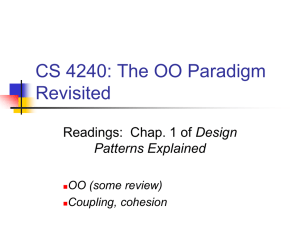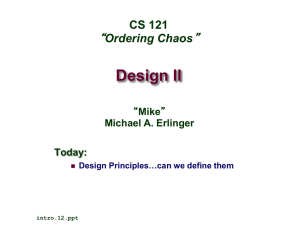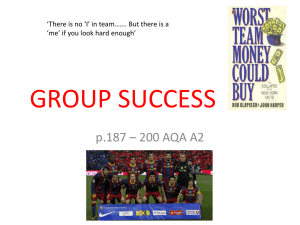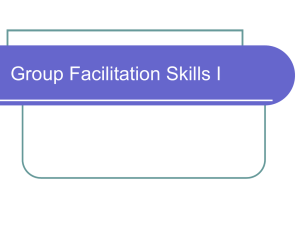lec12- GRASP Patterns
advertisement
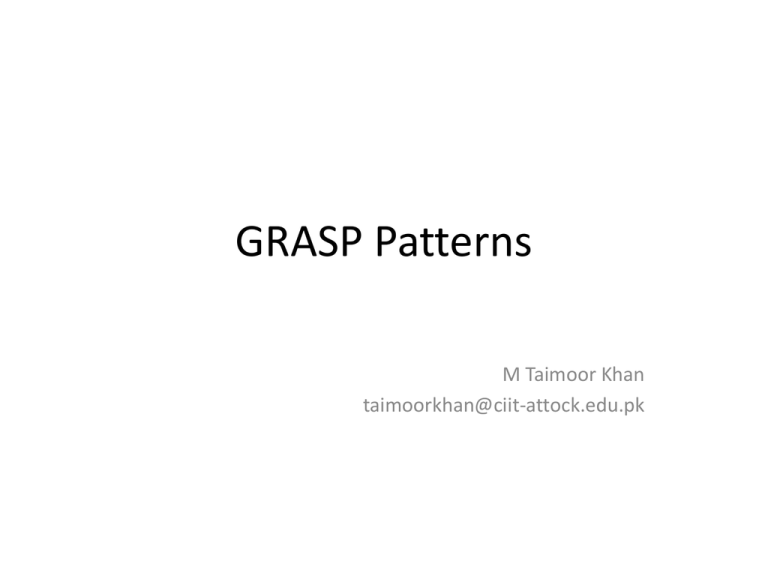
GRASP Patterns M Taimoor Khan taimoorkhan@ciit-attock.edu.pk Patterns • Are not invented. They are harvested from existing solutions. • Are given a name to aid in communications. • Are documented in a rigorous fashion • Sometimes conflict with each other. For example: you apply a patterns to solve one problem, but by doing so, you may introduce others. – This is called a contradiction, or side-effect. – These are the tradeoffs designers have to deal with! GRASP Patterns • Larman introduces a set of basic patterns that he calls GRASP: General Responsibility Assignment Software Pattern • Five GRASP Patterns: – Information Expert – Creator – High Cohesion – Low Coupling – Controller GRASP -Information Expert • Problem : A system will have hundreds of classes. How do I begin to assign responsibilities to them? • Solution : Assign responsibility to the Information Expert–the class that has the information necessary to fulfil the responsibility. • Mechanics : – Step 1: Clearly state the responsibility – Step 2: Look for classes that have the information we need to fulfil the responsibility. – Step 3: Domain Model – Step 4: Sketch out some interaction diagrams. – Step 5: Update the class diagram. GRASP -Information Expert • Discussion Points: – Throughout the process of assigning a responsibility, you may discover many lowerlevel responsibilities • Contradictions: – Sometimes application of the Expert Pattern is undesirable or may have conflict with other responsibilities GRASP -Information Expert GRASP -Information Expert GRASP -Information Expert GRASP –Creator Pattern • Problem : Who creates new instances of some class? • Solution : – – – – – – Let class A create an instance of class B if…. A aggregates(whole-part relationship) B objects A contains B objects A records instances of B objects A closely uses B objects A has initialization data that is needed when creating B objects. • Mechanics: Step 1: Look at Domain / Design model and ask: “Who should be creating these classes”? Step 2:Look for classes that create, aggregate, etc. Step 3:Sketch or update interaction / class diagrams. • Contradictions: Sometimes it’s time consuming GRASP –Creator Pattern GRASP –Low Coupling • Concept –Coupling: • Coupling refers to dementedness, or connectedness. • Our goal is to design for low coupling, so that changes in one element (sub-system, system, class, etc.) will limit changes to other elements. • Low coupling supports increased reuse. • Taken to the extreme, what if we were to design a set of classes with no coupling. • We can’t avoid coupling, but we want to make sure we understand the implications of introducing it and/or the tradeoffs of reducing it. GRASP –Low Coupling Problem: How do you support low dependency, low change impact, and increased reuse. Solution: Assign responsibility so responsibility remains low. Mechanics: – Look for classes with many associations to other classes. – Look for methods that rely on a lot of other methods (or methods in other classes, i.e. dependencies. – Rework your design as needed. GRASP –Low Coupling GRASP –Low Coupling GRASP –High Cohesion Concept –Cohesion: – Cohesion is a measure of “relatedness” – High Cohesion says elements are strongly related to one another – Low Cohesion says elements are not strongly related to one another Low Cohesion examples: • System level : ATM with a use case (function) called “Teller Reports” • Class level: A Student class with a method called “getDrivingRecord(). • Method level: Methods with the word “And” or “Or” in them. • Also applies to subsystem (package) level, component level, etc. • –Designs with low cohesion are difficult to maintain and reuse. • –One of the fundamental goals of an effective design is to achieve high cohesion with low coupling GRASP –High Cohesion Problem: How do you keep complexity manageable? Solution : Assign responsibility so that cohesion remains high. Mechanics : Look for classes with too-few or disconnected methods. • Look for methods that do too much (hint: method name) • Rework your design as needed. Contradictions: • High Cohesion and low coupling are competing forces. GRASP –High Cohesion Additional: • Larman describes degrees of cohesion, from very low to high. For now, just consider that in general, classes with a small number of functionally related methods is more desirables than bloated classes with disconnected methods. • Look at the sequence diagrams for adding a payment to a sale, but this time from the perspective of cohesion. Which version supports high cohesion, and why? • This example illustrates that: • High cohesion and low coupling can be competing forces. • Design is not so clear cut, e.g. it is not always an exact science GRASP -Controller Problem: Who handles events from external actors, e.g. startup(), playSongs(), etc? Solution: Assign the responsibility to a controller class, such as: – A class that represents the overall system, device, or subsystem. Example: Jukebox. – A class that represents a use case. Example: makeSaleHandler. makeSaleCoordinator, etc. – These classes often don’t do the work, but delegate it to others. • Additional: – The decision to create system controllers vs. use case controllers are often driven by the dynamics of high cohesion vs. low coupling. GRASP –Controller Additional : • Watch for bloated controllers. • From an architectural perspective, systems are usually broken upon to layers, or tiers. Example 2 tier client-server, 3 tier, n tier, etc. • The UI objects are in the presentation layer. • The business objects representing the problem domain are in the application or domain layer. • The objects representing databases, network connections, etc. are in the Technical or infrastructure layer(s) • Layering and related decisions are frequently made by an Architect. • Controllers typically receive requests from UI (interface objects). It is not a good idea to put business logic in UI objects Assigning Responsibilities –Other Sources • CRC Cards: • –Another popular technique to assigning responsibilities to classes is to use CRC cards CRC = Class: Responsibility: Collaboration • –Introduced by Kent Beck and Ward Cunnigham



